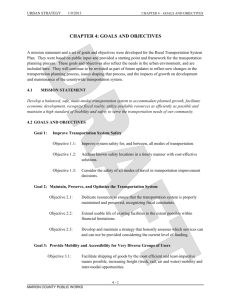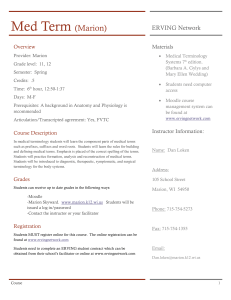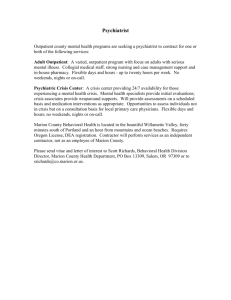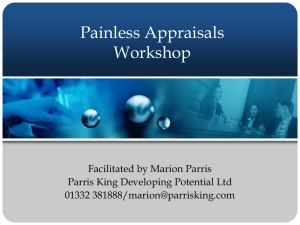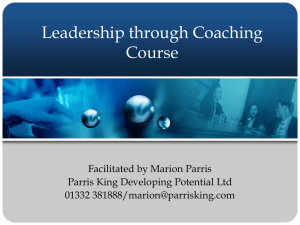It takes 2 to talk - Transcript - New Zealand Federation for Deaf
advertisement
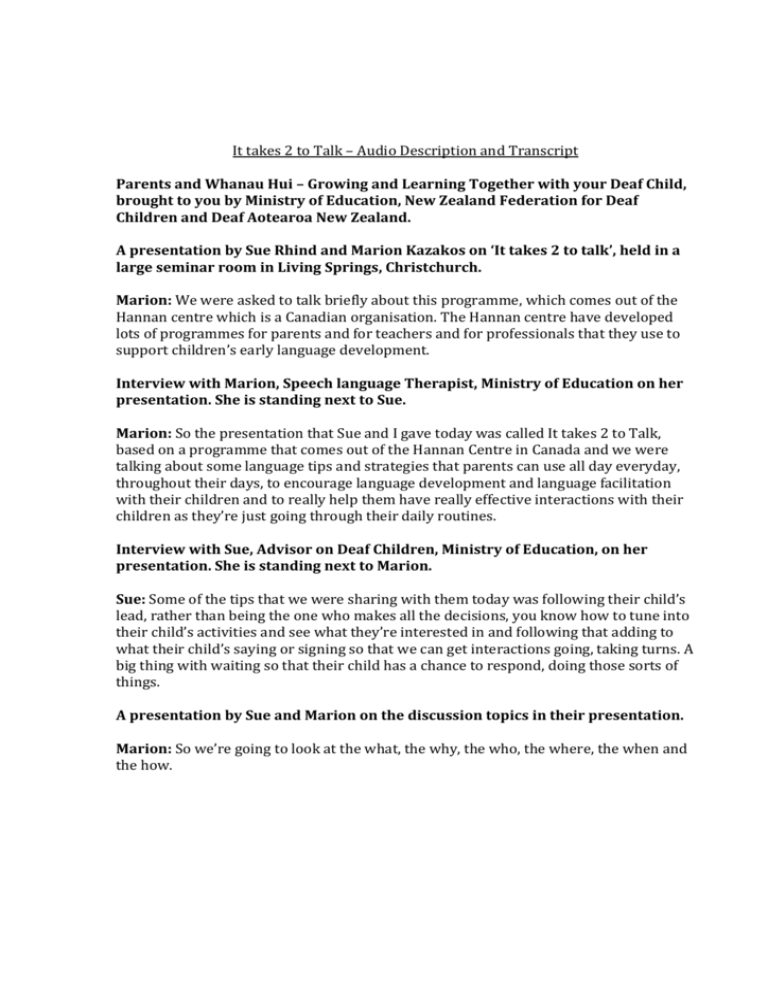
It takes 2 to Talk – Audio Description and Transcript Parents and Whanau Hui – Growing and Learning Together with your Deaf Child, brought to you by Ministry of Education, New Zealand Federation for Deaf Children and Deaf Aotearoa New Zealand. A presentation by Sue Rhind and Marion Kazakos on ‘It takes 2 to talk’, held in a large seminar room in Living Springs, Christchurch. Marion: We were asked to talk briefly about this programme, which comes out of the Hannan centre which is a Canadian organisation. The Hannan centre have developed lots of programmes for parents and for teachers and for professionals that they use to support children’s early language development. Interview with Marion, Speech language Therapist, Ministry of Education on her presentation. She is standing next to Sue. Marion: So the presentation that Sue and I gave today was called It takes 2 to Talk, based on a programme that comes out of the Hannan Centre in Canada and we were talking about some language tips and strategies that parents can use all day everyday, throughout their days, to encourage language development and language facilitation with their children and to really help them have really effective interactions with their children as they’re just going through their daily routines. Interview with Sue, Advisor on Deaf Children, Ministry of Education, on her presentation. She is standing next to Marion. Sue: Some of the tips that we were sharing with them today was following their child’s lead, rather than being the one who makes all the decisions, you know how to tune into their child’s activities and see what they’re interested in and following that adding to what their child’s saying or signing so that we can get interactions going, taking turns. A big thing with waiting so that their child has a chance to respond, doing those sorts of things. A presentation by Sue and Marion on the discussion topics in their presentation. Marion: So we’re going to look at the what, the why, the who, the where, the when and the how. PowerPoint presentation on the ‘What’. The text on the slide reads: Follow your child’s lead. The is a photograph of a man and a child, both drinking out of red cups, looking at each other. Marion: So starting off with the what, we talked a little bit about interaction before. So when two people communicate back and forth through whatever means, what they’re actually doing, with or without words is taking part in an interaction. That’s what we’re really wanting to facilitate more of with our children. To be successful in this interaction, children need to be able to start an interaction and they need to be able to respond when an interaction in initiated by someone else as well. So the big kind of message of the ‘what’ part is that what we’re wanting to be doing is following your child’s lead. Really important for us to follow whatever the child is interested in and they can show us this in a myriad of different ways from the signs and words they use to a look, to a gesture, to a smile, whatever. PowerPoint presentation on the ‘Who’. The text on the slide reads: You!!; The “tuned in” you. Marion: Who’s going to be following the lead in the interaction? It’s going to be the ‘tuned in’ you so it’s the you that’s watching your child to see what sign they’re giving you about what they’re interested in and then you’re straight in there. You’re tuned in and then straight in following their lead. PowerPoint presentation on the ‘When’. The text on the slide reads: Any time – during all your daily routines and activites; bath time, dinner time, play, walks, cooking, driving in the car, getting dressed, playing in the park etc; create opportunities e.g. hiding objects, give 2 choices, offer a little bit then wait Marion: And when? Any time, during all your daily routines and activities so it’s bath time, it’s dinner time, it’s when you go for a walk, it’s play time it’s whatever time. When you’re driving in the car it’s a great time to get those interactions going. Sometimes you might want to create opportunities though. So you might want to do things like hiding objects, so you know they’re going to want the Thomas the Tank Engine train so you just put it behind a cushion so they have to have some interaction to try and find that Thomas the Tank Engine Train and then you look out for those little signs. It might be that they’re just standing there looking around and you tune in straight away and you’re onto that. Giving two choices, do you want the marmite or the honey? Great way to get an interaction started. Offering a little bit and then waiting. Something like bubbles is great for that. So you’re blowing some bubbles, they’re loving that, they’re saying pop its all great then you stop and you wait for them to somehow indicate that they want more it might just be a look and then you blow some more it might be some words, it might be a sign, it might be a gesture, it might be a cry but its some kind of interaction that indicates they some want more. PowerPoint presentation on the ‘How’. The text on the slide reads: Get face to face; OWL; join in and play; imitate, interpret, comment; take turns; add language. Marion: So we’re going to talk through some of these strategies some in a bit more detail than others. Most of these are things that come from the parent program that we talked about but their actually just really good general language strategies so the first one and the easiest one is what we call get face to face. So I don’t want to be up here while my child’s down here playing on the floor. I want to be down low face to face with them so I can connect and share. It’s easier for them to hear and see me and it’s easier to encourage the child to take the lead. PowerPoint presentation on ‘Get face to face’. The text on the slide reads: Connect and shre; easier to hear & see; easier to encourage child to take the lead. There are two photographs. One photograph is of a man and a child colouring in. They are sitting close together and the man has his arm around the child. Their faces are close together. The other photograph is of a woman holding a baby at her level. They are both looking at each other. Marion: They know I’m right with them, I’m right down at their level, I’m in with them. PowerPoint presentation on ‘O.W.L.’. The text on the slide reads: Observe – body language, actions, facial expressions; Wait – stop talking, lean in, look expectantly; Listen. Marion: The next one, O.W.L stands for Observe, Wait and Listen or Look. So we want to observe what the child’s doing so we can follow their interests so that means observing their body language, their actions, their facial expressions anything that gives us an indication of where their interest is. It’s very hard. Sue: So waiting can be a good skill to have, just wait. Marion: And sometimes that means just counting for ten in your head, that’s my little strategy I just count to ten. So we have to stop talking, lean in, get close get face to face, get close, lean in then have a kind of expectant look on your face, not a big kind of (Marion does exaggerated facial expression) but just so that they know you’re waiting for them, that you’re right there with them to see what’s going to happen next and as soon as they do something we can respond. How you respond will be different depending on your child’s stage and level of language development but you respond straight away then you listen or you look if your child’s a signer if they’re not using words we can substitute look for listen. PowerPoint presentation on ‘Imitate, interpret, comment’. The text on the slide reads: Copy their sounds, words, signs, actions; Interpret – put into signs, words what you think they’re trying to tell you; Make a short comment that matches what they’re doing. Can build on what they say. Marion: Imitate copy their sounds, their words, their signs, their actions, their gestures, their smiles, their nods, their bangs, whatever. That banging’s a great example so its just imitate because then they, that’s confidence building for them if you do it they do it they know that they’ve done something pretty good and you can keep that interaction going. ‘Interpret’. So putting into signs or words what you think they’re trying to tell you, you might not get it right, doesn’t matter, you’re trying. So it might be that sound that you’re not quite sure what it means but you can interpret it as perhaps a, maybe not for a seven month old. a growly monster kind of sound or something so you hear a sound or word, you’re pretty sure you know what it means, interpret as such and carry on they’ll soon tell you if you haven’t done it right. PowerPoint presentation on ‘Take turns’. The text on the slide reads: Helps them stay in interaction longer; turns can look different (from a look, to pointing, to a sentence); match your turns to your child’s length, pace, interest; cue and wait. Marion: We talked about interactions we want our child to initiate the interactions, respond to the interactions we want them also to stay in those interactions for as long as we can, not to loose interest. So the way to get them to stay in interactions is to take turns. Turns can look different a turn might be a look, might be a point, might be a gesture it might be a word, it might be a phrase. Sue: Might be a knock Marion: Could be a knock. So it could be all range of different things we need to be tuned into those turns, recognize them as such and then respond. A question is another good cue, where going to talk about questions next, we don’t want to overuse questions so it would be one question at a time and then we’re going to? Audience member: Wait. Marion: That’s right. PowerPoint presentation on ‘Questions’. The text on the slide is in two columns. The text on the left reads: choice questions; yes or no questions; wh questions. The text on the right reads: questions that test; questions that are too hard; questions that don’t follow their interest; too many questions; questions that don’t give time. Turn questions into comments! Marion: So choice questions are fantastic, do you want this? Do you want this ? Really good because you can use those visuals as well often because you’ve got those two things with you, the marmite and the nutella its right there. Yes or no questions particularly good for children who aren’t taking many terms or haven’t got much language they can either nod or shake their head to indicate the yes or no. So do you want the milk? You know they don’t want the milk or they might push it away. And then a little bit further down in their development will be the development of ‘wh’ questions so particularly what, who and where so we can ask those type of questions to help keep that interaction going. What we want to try and avoid with questions are these ones, so we don’t want to ask many questions that tests because we’re not testing our children were interacting with them, we don’t want to ask them questions that are too hard you’re not going to go anywhere with that, don’t want ask questions that aren’t following their interest, we don’t want to ask too many questions and we don’t want to ask questions that don’t give time. A really good thing to do then is to a use those three types of questions on the left but also turn your questions into comments that way you want be falling into the trap of asking to many questions. Repeat, repeat, repeat. which was the thing I was talking to Melissa about earlier. Can’t stress that enough either, repeat repeat repeat. We don’t have to expect them to respond or copy it back but we need to repeat these words often and in different contexts. So it might be that you’re trying to get the concept of a word like ‘on’ so you can talk about putting your sock on, put your hat on, put your gloves on and then in a different context you can turn the light on, turn the tap on, turn the switch on, put something on the table so they’re hearing that word on over and over and over again or seeing the sign for the word ‘on’ over and over and over again. Repeat repeat repeat, but don’t necessarily expect them to copy that back right now but you’ll be feeding it in over and over. Interview with Sue, on what she hopes parents have taken away from the presentation. She is standing next to Marion. I hope that the families, that the parents took away with them just the ideas about how to do interactions with their children during the day. That they feel its not something that’s an added thing that they have to worry about its just ‘I’ve got the skills and strategies to be able to develop my Childs language through natural interactions through the routines of everyday.’ PowerPoint on Top Tips for ‘It takes two to talk’. Top Tips: Follow your child’s lead. Talk about things your child is interested in and extend this language. It’s all about using the routines in your day for great interactions with your child – the opportunities are endless and so are the ways of doing it. Some to try: - Get face to face - Join and play - Comment and share - O.W.L. – observe, wait (e.g. count to 10) and look / listen - Imitate, interpret, comment - Take turns - Add language - Questions – choice, yes/no, ‘wh’ - Be patient Ministry of Education logo, Deaf Aotearoa New Zealand logo, NZ Federation for Deaf Children logo.
